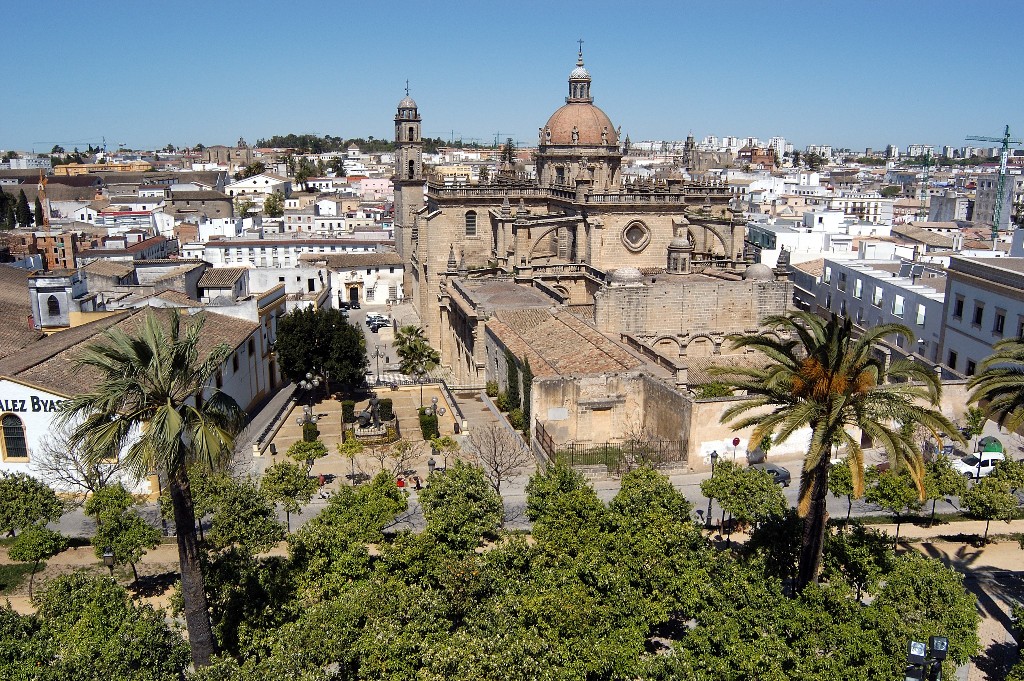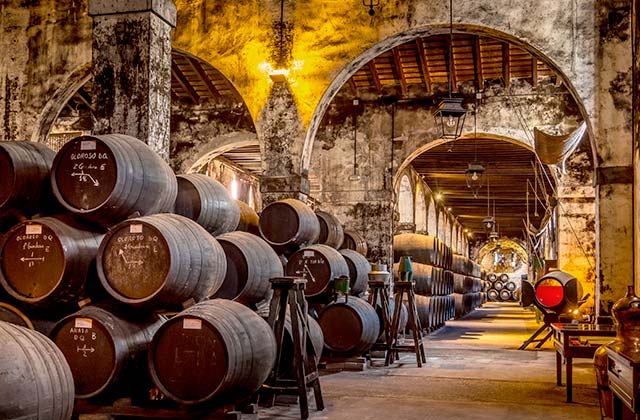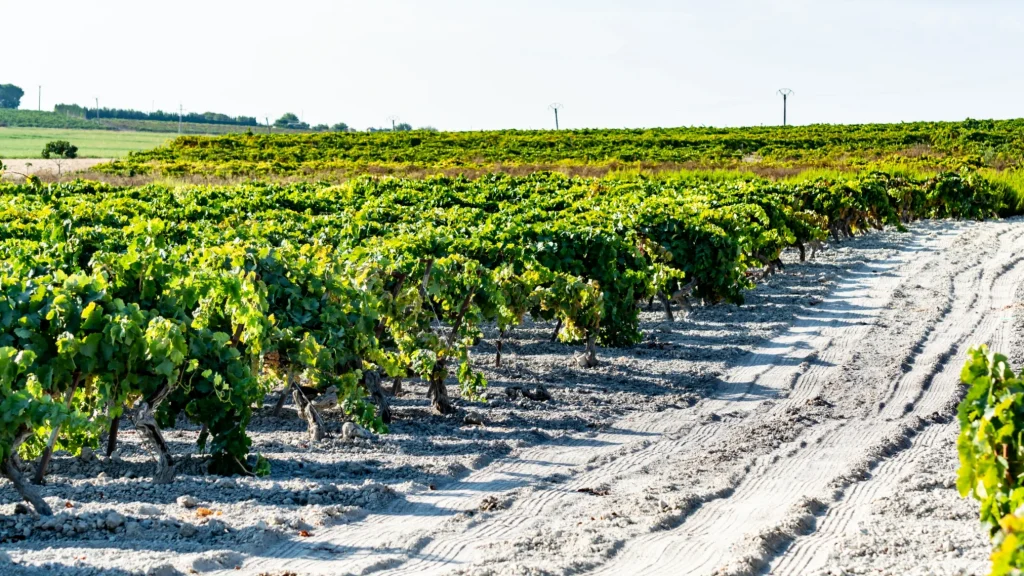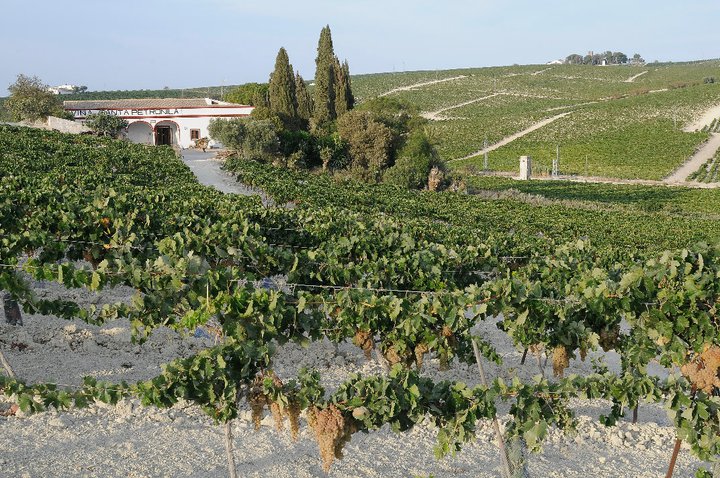Sherry Lures Travellers to Jerez De La Frontera

By: Habeeb Salloum/Arab America Contributing Writer
The Arab geographer, Ibn Abd al- Munim, when describing Jerez de la Frontera and its countryside some 1000 years ago, wrote that Jerez’s countryside is beautiful to behold, containing olive groves, fig trees and vineyards. It appeared to us as we drove into town that with the exception of endless sunflower fields and more vineyards, not a great deal, except the invention of sherry, has changed from that era. We had come to Andalusia, where in Jerez this wine first saw the light, to sample what some Spaniards call the ‘amber nectar’.
When, after a tour of the winery, we sat down for a taste of the wine produced by Bodegas Domecq, one of the 40 sizable wine cellars in Jerez de la Frontera, I couldn’t believe my eyes. On the table there were a half dozen bottles of various types of Domecq sherries and brandies – all for us to enjoy to our hearts’ content. Unlike the sips that are offered by the wineries of North America, here in the sherry world of southern Spain, guests are treated with pampered hospitality – a trait prevalent in Andalusia when it comes to travellers.
The scores of wine bodegas in town have made Jerez, a city of some 200,000, world famous for its sherries. Only two hours by auto from Seville and less than a half hour drive from
Cadiz, this sherry and brandy town par excellence is a quiet and pleasant urban centre – but it was not always so.
For a number of centuries, it marked the frontier between Muslim Granada and Christian Spain, changing hands several times during the Reconquista. Its once Roman appellation, ‘Caesaris’, was corrupted by the Arabs to Xeres – later changed by the Spaniards to Jerez, hence its name, ‘Jerez of the Frontier’.
The Phoenicians who were the first outsiders to settle the region, finding the white chalky soil known as albarizas, between the rivers Guadalquiver, Guadalete and the sea, ideal for growing grapes, introduced the vine. These `white lands’ in autumn and winter soak up the rainwater like a sponge. In summer, when temperatures reach over 40 C (105 F), the land closes up like a clam, allowing the vine roots to sustain themselves on the remaining moisture.

In Roman times, Jerez and the surrounding area became one of the top wine-producing areas in the Iberian Peninsula. After the Arabs in 712 occupied the city, the wine industry dwindled. In the years following its reconquest by the Christians, British merchants settled in town to trade. Later British Catholic refugees who had been persecuted in England later joined them. The descendants of these émigrés founded the great sherry firms or bodegas in town – many of which carry English names like Humbert, Williams and John Harvey. The name, sherry itself, originates from that era. It comes from the town’s Arabic name, Xeres {pronounced sharish}.
Two thirds of the grapes grown in the Jerez de la Frontera area are of the Palomino variety, and one third of the Pedro Ximénez and Moscatal varieties – the two types used to give sweetness, especially to the sweet sherries. The grapes are harvested in early September and pressed. The pulp then goes into vats where the juice is separated by gravity. The juice is transferred afterwards to the always-kept humid bodegas to spend a few weeks in fermentation.

Soon flor, a puffy layer of scum that is actually a yeast, begins to form on the surface. The flor prevents oxidization and adds a special flavour to the wine. The subtle nature of the flor, the ingredient that apparently cannot be duplicated by competitors, gives the uniqueness to the sherries of Jerez. However, the yeast is only allowed to grow on the finos or dry sherries; for the sweeter sherries, the flor is killed by adding up to 17% of alcohol just before the wine enters the solera system – the method used to produce sherry.
None of the sherries depend on the year’s vintage. All are the products of blending, using the solera system. In every bodega, hundreds of barrels or butts, made of American oak, are arranged in rows, stacked over each other up to six tiers deep.
Three times a year, 10% of each barrel in the bottom row is drawn off, then refilled by 10% from the row above. The top row is then filled from the current pressing. As the sherry travels downward, it mingles with and becomes strengthened by the older wines, arriving at the same character and balance as that of its predecessor.
Unlike what sometimes happens in the production of other wines, there are no poor sherry years. One season’s harvest can always be compensated for by an infusion from a better year somewhere along the solera ladder. Sherries must conform in taste, smell and colour to the stringent standards laid down by the bodega‘s owners.
There four basic types of sherry on the market: the bone dry finos, popular in Andalusia with seafood and tapas; the deeper and fuller amontillados with their nutty flavour; the rich-smelling and sweet olorosos; and the sugar-sweet dulces, like Manzanilla and cream sherries – made from oloroso mixed with a sweet wine.

In the past, the name sherry has been misused for a wide range of fortified wines, but from the mid 1990’s, within the European Union, the name has been restricted to the substantial produce of Jerez de la Frontera and the neighbouring towns of Puerto Santa María and Salúcar de Barrameda. At any one time, there are more than a million barrels of sherry maturing in their vats above ground cellars.
Most of this huge production is consumed in Andalusia – very little is on the daily menu in other parts of Spain. Great Britain is, and always has been, the largest external market. Since sherry was introduced into England in 1608, around 70% of the sherry exported has been shipped to that country. The Netherlands and Germany, lagging a long way behind, account for most of the remainder of the exports.
Jerez proudly claims to have invented the sherry, which the Andalusians call the ‘wine of the sky’ and ‘the glory of Andalusia’. Throughout this Spanish province, sherry is considered to be noble, precious and special. Far from being an everyday social drink, like champagne in other countries, it is served at feast days, celebrations and weddings.
Jerez’s magnificent combination of climate, soil and vines have made it an ideal spot to give birth to sherry – considered by the southern Spaniards as epitome of wines. That day as we generously tasted the wines produced in the Bodegas Domecq, I agreed with the Andalusians – sherries, from the drys to the sweets, are delectable.


